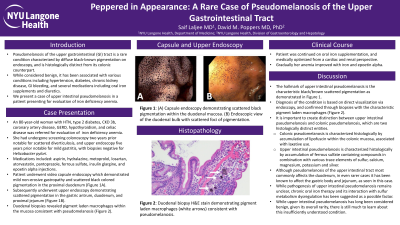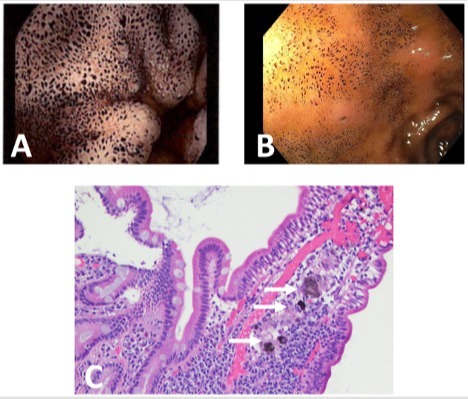Back


Poster Session A - Sunday Afternoon
Category: General Endoscopy
A0281 - Peppered in Appearance: A Rare Case of Pseudomelanosis of the Upper Gastrointestinal Tract
Sunday, October 23, 2022
5:00 PM – 7:00 PM ET
Location: Crown Ballroom

Has Audio

Saif Laljee, MD
New York University Langone Medical Center
New York, NY
Presenting Author(s)
Saif Laljee, MD1, David M. Poppers, MD, PhD2
1New York University Langone Medical Center, New York, NY; 2NYU Langone Health, New York, NY
Introduction: Pseudomelanosis of the upper gastrointestinal tract (GI) is a rare condition characterized by a diffuse black-brown speckled pigmentation within the intestinal mucosa. Usually identified incidentally on endoscopy, upper intestinal pseudomelanosis is more frequently seen in the duodenum, but can rarely also be seen in the gastric body and jejunum. While this condition has been reported in literature, pathogenesis and clinical course are still largely unknown. Here we describe a case of pseudomelanosis in a patient referred for iron deficiency anemia.
Case Description/Methods: An 80-year-old woman with a history notable for hypertension, type 2 diabetes, chronic kidney disease, coronary artery disease, gastroesophageal reflux disease, hypothyroidism, and celiac disease was referred for evaluation of iron deficiency anemia.
On review, she had undergone screening colonoscopy two years ago, notable for scattered diverticulosis, and upper endoscopy five years ago notable only for mild gastritis. Medications included: aspirin, hydralazine, metoprolol, losartan, atorvastatin, pantoprazole, ferrous sulfate, and insulin glargine.
She initially underwent video capsule endoscopy, revealing mild non-erosive gastropathy and scattered black pigmentation in the duodenum (Figure 1A). She subsequently underwent upper endoscopy demonstrating scattered pigmentation in the gastric antrum, duodenum, and proximal jejunum (Figure 1B). Duodenal biopsies revealed pigment laden macrophages within the mucosa consistent with pseudomelanosis duodeni (Figure 1C).
Discussion: Pseudomelanosis of the upper intestinal tract is a rare and poorly understood condition. While considered benign, it has been associated with various conditions including hypertension, diabetes mellites, chronic kidney disease, gastrointestinal bleeding, and with medications including oral iron supplements and diuretics—many of which were seen in this case.
Unlike colonic pseudomelanosis, which is histologically characterized by accumulation of lipofuscin within the colonic mucosa and is associated with laxative use, pseudomelanosis of the upper intestinal tract is histologically distinct, characterized by accumulation of ferrous sulfate containing compounds.
To date, pathogenesis of the condition remains unclear. Given the rarity of upper intestinal pseudomelanosis, prognosis and treatment have also yet to be determined. This reports aims to increase awareness of this rare and incompletely understood condition.

Disclosures:
Saif Laljee, MD1, David M. Poppers, MD, PhD2. A0281 - Peppered in Appearance: A Rare Case of Pseudomelanosis of the Upper Gastrointestinal Tract, ACG 2022 Annual Scientific Meeting Abstracts. Charlotte, NC: American College of Gastroenterology.
1New York University Langone Medical Center, New York, NY; 2NYU Langone Health, New York, NY
Introduction: Pseudomelanosis of the upper gastrointestinal tract (GI) is a rare condition characterized by a diffuse black-brown speckled pigmentation within the intestinal mucosa. Usually identified incidentally on endoscopy, upper intestinal pseudomelanosis is more frequently seen in the duodenum, but can rarely also be seen in the gastric body and jejunum. While this condition has been reported in literature, pathogenesis and clinical course are still largely unknown. Here we describe a case of pseudomelanosis in a patient referred for iron deficiency anemia.
Case Description/Methods: An 80-year-old woman with a history notable for hypertension, type 2 diabetes, chronic kidney disease, coronary artery disease, gastroesophageal reflux disease, hypothyroidism, and celiac disease was referred for evaluation of iron deficiency anemia.
On review, she had undergone screening colonoscopy two years ago, notable for scattered diverticulosis, and upper endoscopy five years ago notable only for mild gastritis. Medications included: aspirin, hydralazine, metoprolol, losartan, atorvastatin, pantoprazole, ferrous sulfate, and insulin glargine.
She initially underwent video capsule endoscopy, revealing mild non-erosive gastropathy and scattered black pigmentation in the duodenum (Figure 1A). She subsequently underwent upper endoscopy demonstrating scattered pigmentation in the gastric antrum, duodenum, and proximal jejunum (Figure 1B). Duodenal biopsies revealed pigment laden macrophages within the mucosa consistent with pseudomelanosis duodeni (Figure 1C).
Discussion: Pseudomelanosis of the upper intestinal tract is a rare and poorly understood condition. While considered benign, it has been associated with various conditions including hypertension, diabetes mellites, chronic kidney disease, gastrointestinal bleeding, and with medications including oral iron supplements and diuretics—many of which were seen in this case.
Unlike colonic pseudomelanosis, which is histologically characterized by accumulation of lipofuscin within the colonic mucosa and is associated with laxative use, pseudomelanosis of the upper intestinal tract is histologically distinct, characterized by accumulation of ferrous sulfate containing compounds.
To date, pathogenesis of the condition remains unclear. Given the rarity of upper intestinal pseudomelanosis, prognosis and treatment have also yet to be determined. This reports aims to increase awareness of this rare and incompletely understood condition.

Figure: Figure 1: (A) Capsule endoscopy demonstrating scattered black-brown pigmentation within the duodenal mucosa. (B) Endoscopic view of the duodenal bulb with scattered foci of pigmentation. (C) Duodenal biopsy demonstrating pigment laden macrophages (white arrows) consistent with pseudomelanosis.
Disclosures:
Saif Laljee indicated no relevant financial relationships.
David Poppers: AbbVie – Consultant, Speakers Bureau. Exact Sciences – Advisory Committee/Board Member, Consultant. Lucid Diagnostics – Consultant, Speakers Bureau, Stock Options. MicroTech Endoscopy – Consultant. Olympus – Consultant. RedHill BioPharma – Speakers Bureau. Salix Pharmaceuticals/Bausch Health – Advisory Committee/Board Member, Consultant, Speakers Bureau. Steris – Consultant. Thoracent – Consultant.
Saif Laljee, MD1, David M. Poppers, MD, PhD2. A0281 - Peppered in Appearance: A Rare Case of Pseudomelanosis of the Upper Gastrointestinal Tract, ACG 2022 Annual Scientific Meeting Abstracts. Charlotte, NC: American College of Gastroenterology.
